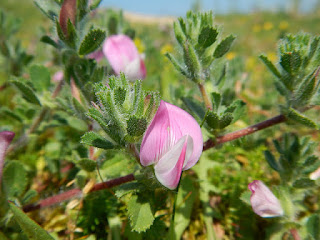By Helen Roberts
Beachcombing is fun no matter what your age. Shells, pieces of driftwood and cloudy coloured glass somehow find a way into pockets, rucksack compartments and lunchboxes. A holiday to Slapton, in the South Hams, over the summer cemented our family’s curiosity in scouring the beaches. But whilst beachcombing, I was also similarly intrigued by the plants growing in this environment.
The coast here has a constantly shifting flora highly specialised for growing in difficult conditions. There is a shingle ridge that runs parallel to the shoreline, dividing the lake (Slapton Ley) from the sea. The plants that I discovered along the ridge path that runs northeast from the village of Torcross looked so intrinsically a part of the place, that to me they amplified the essence of this unique shingle coast.
All of the species on the shingle ridge have evolved ways of coping with difficult coastal conditions. The plants here are frequently subjected to saline spray and blown salts, high winds, exposure to hot summer temperatures and low soil humidity. The physical makeup of the shingle (it is a mix of flint, chert and quartz intermixed with some finer material) means that the substrate is very free draining and this results in the acute leaching of nutrients.
Thick leaves and deep roots
Most species that grow here have developed a cuticle (the protective film covering the leaf) that resists the entry of salt water or the leaves are sclerophyllous (thick, waxy and leathery). Often leaves are succulent and allow more effective retention of water.
 |
| Giant leaved sea kale (Crambe maritima) Photo credit: Peganum [via Flickr CC BY-SA 2.0] |
White hairs on the leaf surface, which give a silvery hue, are also adaptive in preventing evaporation as they trap moisture, conserving water within their microclimate. The yellow horned-poppy (Glaucium flavum) has hairy sclerophyllous leaves. This is a toxic but striking perennial, with bright yellow flowers that later produce a stunning display of long horned seedpods. This plant has an extremely deep root system in order to access water deep down, but this also helps with stability during high winds.
Other plants on the shingle bar include the beautifully architectural rock samphire (Crithmum maritimum) and the giant leaved sea kale (Crambe maritima), the latter becoming popularised through its abundance in Derek Jarman’s extraordinary shingle garden near Dungeness. Sea kale taproots reach depths of up to 2 metres, providing them with a significant anchor in coastal winds.
Lying low
 |
| Restharrow (Ononis repens) is a common beach dweller. Photo credit: Matt Lavin [via Flickr CC BY-SA 2.0] |
Some plants have adapted a slightly different approach to coastal living. They nestle down as low as they can and spread horizontally to reduce the amount of surface area exposed to the hammering winds. The small fleshy leaves of the sea campion (Silene uniflora) are closely packed and the plant grows in low mats. It is only the flowering branches, with their pretty white flowers and inflated bladders, much like calyx, that dare poke their heads up into the wind. Restharrow (Ononis repens) is an attractive low creeping aromatic herb with hairy stems and small pink pea-like flowers. The evaporation of essential oils released by aromatic plants is thought to cool the environment around the plant and thereby protect it from periods of extreme heat. Restharrow also has an extensive root system. Other species like chicory (Cichorium intybus), viper’s-bugloss (Echium vulgare), thrift (Armeria maritima), wild carrot (Daucus carota) and bird’s-foot-trefoil (Lotus corniculatus) all grow on the shingle ridge and are highly prized by pollinating insects.
These species have adapted to this environment. Although the ridge is only a narrow two metre strip of shingle, it displays a wonderful mosaic of disturbed ruderal* vegetation that forms a linear ribbon of interesting shapes, forms and flowers. Observing this particular plant habitat has helped me in the development of my own gravel garden at home. Some of these species are better suited to a garden environment and so I will begin with these. Although, more often than not it’s a matter of trial and error when trying to take plants outside of the conditions in which they thrive. Beth Chatto’s famous mantra, ‘Right plant, right place’ springs to mind and is always in my thoughts when I am planting my own garden or designing for other people.
*Ruderal is a term in botany that refers to plants that grow on waste ground or among rubbish.
Helen Roberts is a trained landscape architect with a background in plant sciences. She is a probationary member of the Garden Media Guild and a regular contributor to the University of Bristol Botanic Garden blog.

